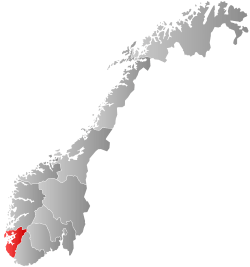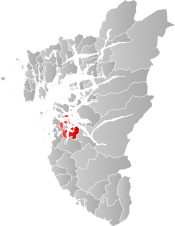Hetland
Hetland is a former municipality in Rogaland county, Norway. The municipality existed from 1838 until 1965 when it was dissolved. The municipality included the Stavanger Peninsula and the land surrounding both sides of the Gandsfjorden, but not the area around the head of the fjord. It originally encompassed the land surrounding the city of Stavanger in the present-day municipalities of Randaberg and Stavanger (except the city of Stavanger) and part of the municipality of Sandnes. The main church for Hetland was Hetland Church (now named "Frue Church"). Upon its dissolution in 1965, the 92-square-kilometre (36 sq mi) municipality had 24,173 residents.[2]
Hetland kommune | |
|---|---|
View of Grødem village | |
 Rogaland within Norway | |
 Hetland within Rogaland | |
| Coordinates: 58°53′32″N 05°44′01″E | |
| Country | Norway |
| County | Rogaland |
| District | Jæren |
| Established | 1 Jan 1838 |
| Disestablished | 1 Jan 1965 |
| Area | |
| • Total | 92 km2 (36 sq mi) |
| *Area at municipal dissolution. | |
| Population (1965) | |
| • Total | 24,173 |
| • Density | 260/km2 (680/sq mi) |
| Demonym(s) | Hetlandsbu[1] |
| Time zone | UTC+01:00 (CET) |
| • Summer (DST) | UTC+02:00 (CEST) |
| ISO 3166 code | NO-1126 |
| Created as | Formannskapsdistrikt in 1838 |
| Succeeded by | Sandnes and Stavanger in 1965 |
History

The parish of Hetland was established as a municipality on 1 January 1838 (see formannskapsdistrikt law). On 1 July 1922, the northwestern district of the municipality (population: 1,256) was separated to form the new municipality of Randaberg. This split left Hetland with 10,167 residents. The port city of Stavanger was located along the Gandsfjorden, adjacent to Hetland and as the city expanded over the years, areas of Hetland were annexed to join the city. Such changes happened in 1867, 1879, 1906, 1923, and 1953. Also on 1 January 1912, a small area in Høyland municipality (population: 41) was transferred to Hetland.
On 1 January 1965, there were many major municipal changes in Norway due to the work of the Schei Committee. On that date, Hetland municipality was dissolved and its lands were transferred to its neighbors. The parts of Hetland located east of the Gandsfjorden, namely the districts of Riska and Dale (population: 2,077) were merged into a much larger Sandnes municipality. The rest of Hetland, located on the west side of the fjord (population: 20,861) was merged into the municipality of Stavanger, greatly expanding its size.[3]
Government
All municipalities in Norway, including Hetland, are responsible for primary education (through 10th grade), outpatient health services, senior citizen services, unemployment and other social services, zoning, economic development, and municipal roads. The municipality is governed by a municipal council of elected representatives, which in turn elects a mayor.[4]
Municipal council
The municipal council (Herredsstyre) of Hetland was made up of representatives that were elected to four year terms. The party breakdown of the final municipal council was as follows:
| Party Name (in Norwegian) | Number of representatives | |
|---|---|---|
| Labour Party (Arbeiderpartiet) | 17 | |
| Conservative Party (Høyre) | 10 | |
| Christian Democratic Party (Kristelig Folkeparti) | 4 | |
| Centre Party (Senterpartiet) | 2 | |
| Liberal Party (Venstre) | 8 | |
| Total number of members: | 41 | |
| Party Name (in Norwegian) | Number of representatives | |
|---|---|---|
| Labour Party (Arbeiderpartiet) | 16 | |
| Conservative Party (Høyre) | 8 | |
| Christian Democratic Party (Kristelig Folkeparti) | 5 | |
| Centre Party (Senterpartiet) | 2 | |
| Liberal Party (Venstre) | 10 | |
| Total number of members: | 41 | |
| Party Name (in Norwegian) | Number of representatives | |
|---|---|---|
| Labour Party (Arbeiderpartiet) | 16 | |
| Conservative Party (Høyre) | 6 | |
| Christian Democratic Party (Kristelig Folkeparti) | 4 | |
| Farmers' Party (Bondepartiet) | 2 | |
| Liberal Party (Venstre) | 10 | |
| Joint List(s) of Non-Socialist Parties (Borgerlige Felleslister) | 3 | |
| Total number of members: | 41 | |
| Party Name (in Norwegian) | Number of representatives | |
|---|---|---|
| Labour Party (Arbeiderpartiet) | 15 | |
| Conservative Party (Høyre) | 5 | |
| Christian Democratic Party (Kristelig Folkeparti) | 4 | |
| Farmers' Party (Bondepartiet) | 2 | |
| Liberal Party (Venstre) | 11 | |
| Joint List(s) of Non-Socialist Parties (Borgerlige Felleslister) | 2 | |
| Local List(s) (Lokale lister) | 1 | |
| Total number of members: | 40 | |
| Party Name (in Norwegian) | Number of representatives | |
|---|---|---|
| Labour Party (Arbeiderpartiet) | 8 | |
| Conservative Party (Høyre) | 4 | |
| Communist Party (Kommunistiske Parti) | 2 | |
| Christian Democratic Party (Kristelig Folkeparti) | 2 | |
| Farmers' Party (Bondepartiet) | 2 | |
| Liberal Party (Venstre) | 9 | |
| List of workers, fishermen, and small farmholders (Arbeidere, fiskere, småbrukere liste) | 1 | |
| Joint List(s) of Non-Socialist Parties (Borgerlige Felleslister) | 4 | |
| Total number of members: | 32 | |
| Party Name (in Norwegian) | Number of representatives | |
|---|---|---|
| Labour Party (Arbeiderpartiet) | 10 | |
| Conservative Party (Høyre) | 3 | |
| Communist Party (Kommunistiske Parti) | 2 | |
| Christian Democratic Party (Kristelig Folkeparti) | 2 | |
| Farmers' Party (Bondepartiet) | 2 | |
| Liberal Party (Venstre) | 7 | |
| List of workers, fishermen, and small farmholders (Arbeidere, fiskere, småbrukere liste) | 3 | |
| Local List(s) (Lokale lister) | 3 | |
| Total number of members: | 32 | |
| Party Name (in Norwegian) | Number of representatives | |
|---|---|---|
| Labour Party (Arbeiderpartiet) | 9 | |
| Conservative Party (Høyre) | 4 | |
| Farmers' Party (Bondepartiet) | 3 | |
| Liberal Party (Venstre) | 10 | |
| Joint List(s) of Non-Socialist Parties (Borgerlige Felleslister) | 3 | |
| Local List(s) (Lokale lister) | 3 | |
| Total number of members: | 32 | |
References
- "Navn på steder og personer: Innbyggjarnamn" (in Norwegian). Språkrådet.
- Store norske leksikon. "Hetland" (in Norwegian). Retrieved 15 March 2016.
- Jukvam, Dag (1999). "Historisk oversikt over endringer i kommune- og fylkesinndelingen" (PDF) (in Norwegian). Statistisk sentralbyrå.
- Hansen, Tore, ed. (12 May 2016). "kommunestyre". Store norske leksikon (in Norwegian). Kunnskapsforlaget. Retrieved 13 July 2020.
- "Kommunevalgene 1963" (PDF) (in Norwegian). Oslo: Statistisk sentralbyrå. 1964. Retrieved 14 July 2020.
- "Kommunevalgene og Ordførervalgene 1959" (PDF) (in Norwegian). Oslo: Statistisk sentralbyrå. 1960. Retrieved 14 July 2020.
- "Kommunevalgene og Ordførervalgene 1955" (PDF) (in Norwegian). Oslo: Statistisk sentralbyrå. 1957. Retrieved 14 July 2020.
- "Kommunevalgene og Ordførervalgene 1951" (PDF) (in Norwegian). Oslo: Statistisk sentralbyrå. 1952. Retrieved 14 July 2020.
- "Kommunevalgene og Ordførervalgene 1947" (PDF) (in Norwegian). Oslo: Statistisk sentralbyrå. 1948. Retrieved 14 July 2020.
- "Kommunevalgene og Ordførervalgene 1945" (PDF) (in Norwegian). Oslo: Statistisk sentralbyrå. 1947. Retrieved 14 July 2020.
- "Kommunevalgene og Ordførervalgene 1937" (PDF) (in Norwegian). Oslo: Statistisk sentralbyrå. 1938. Retrieved 14 July 2020.

